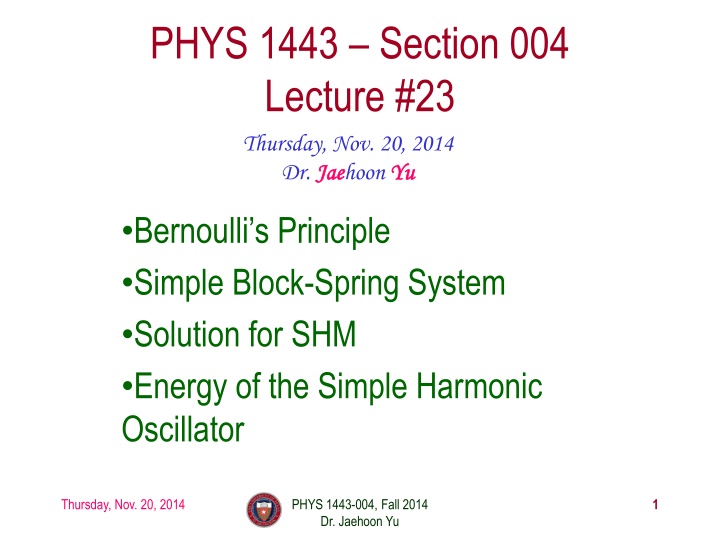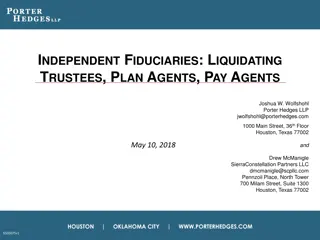
Understanding Bernoulli's Principle and Equation in Fluid Mechanics
Explore Bernoulli's Principle which explains the relationship between fluid velocity and pressure, along with deriving the energy equation for fluids in motion. Learn how to apply Bernoulli's Equation to analyze fluid flow behavior in different scenarios.
Download Presentation

Please find below an Image/Link to download the presentation.
The content on the website is provided AS IS for your information and personal use only. It may not be sold, licensed, or shared on other websites without obtaining consent from the author. If you encounter any issues during the download, it is possible that the publisher has removed the file from their server.
You are allowed to download the files provided on this website for personal or commercial use, subject to the condition that they are used lawfully. All files are the property of their respective owners.
The content on the website is provided AS IS for your information and personal use only. It may not be sold, licensed, or shared on other websites without obtaining consent from the author.
E N D
Presentation Transcript
PHYS 1443 Section 004 Lecture #23 Thursday, Nov. 20, 2014 Dr. Jae Jaehoon Yu Yu Bernoulli s Principle Simple Block-Spring System Solution for SHM Energy of the Simple Harmonic Oscillator Thursday, Nov. 20, 2014 PHYS 1443-004, Fall 2014 Dr. Jaehoon Yu 1
Announcements Last Quiz Beginning of the class coming Tuesday, Nov. 25 Covers CH14.1 through what we finish today (CH15.1?) BYOF Final comprehensive exam In this room, 9:00 10:30am, Thursday, Dec. 11 Covers CH 1.1 through what we finish Tuesday, Dec. 2 plus the math refresher Mixture of multiple choice and free response problems Bring your calculator but DO NOT input formula into it! Your phones or portable computers are NOT allowed as a replacement! You can prepare a one 8.5x11.5 sheet (front and back) of handwritten formulae and values of constants for the exam None of the parts of the solutions of any problems No derived formulae, derivations of equations or word definitions! Do NOT Miss the exam! Tuesday, Nov. 4, 2014 PHYS 1443-004, Fall 2014 Dr. Jaehoon Yu 2
Bernoullis Principle Bernoulli s Principle: Where the velocity of fluid is high, the pressure is low, and where the velocity is low, the pressure is high. Amount of the work done by the force, F1, that exerts pressure, P1, at point 1 W = F1 Dl1= 1 Amount of the work done by the force on the other section of the fluid is W = F2 Dl2= PA l 1 1 1 P A l 2 2 2 2 Work done on the gravitational force to move the fluid mass, m, from y1 to y2 is W = mg y F2 ( ) F1 y 3 2 1 Thursday, Nov. 20, 2014 PHYS 1443-004, Fall 2014 Dr. Jaehoon Yu 3
Bernoullis Equation contd The total amount of the work done on the fluid is W = 1 PA l = From the work- kinetic energy principle 1 2mv Since the mass m is contained in the volume that flowed in the motion A l = and m = 2 2 A l 1 2 l P A + + + P A l mgy mgy W W W 1 1 2 2 2 2 1 2 3 1 1 2mv + = 2 2 2 1 P A l mgy mgy PA l 2 2 2 2 1 1 1 1 A l = A l 1 1 1 1 2 2 1 2 Thus, A l 2 1 A l v 2 v 1 1 2 2 2 = A l + A l gy PA l gy 2 2 2 1 1 1 2 2 2 1 1 1 Thursday, Nov. 20, 2014 PHYS 1443-004, Fall 2014 Dr. Jaehoon Yu 4
Bernoullis Equation contd 2 2 A l A l = Since 1 1 1 2 1 2 A l A l = A l A l A l + A l 2 2 2 1 v v P P g y gy 2 2 1 1 2 1 1 1 1 2 2 2 2 2 2 1 1 1 1 2 We obtain = + 2 2 2 1 v v P P gy gy 1 2 2 1 1 2 1 2 Bernoulli s Equation Re- organize + + = + + 2 1 2 2 P v gy P v gy 1 1 2 2 1 2 Result of Energy conservation! Thus, for any two points in the flow + + ( = 2 1 . const ) = P v gy 1 1 + g y 2P = + Pascal s Law P y 1P gh For static fluid 1 1 2 1 2 ( ) = + 2 1 2 2 P P v v For the same heights 2 1 The pressure at the faster section of the fluid is smaller than slower section. Thursday, Nov. 20, 2014 PHYS 1443-004, Fall 2014 Dr. Jaehoon Yu 5
Ex. for Bernoullis Equation Water circulates throughout a house in a hot-water heating system. If the water is pumped at the speed of 0.5m/s through a 4.0cm diameter pipe in the basement under a pressure of 3.0atm, what will be the flow speed and pressure in a 2.6cm diameter pipe on the second 5.0m above? Assume the pipes do not divide into branches. Using the equation of continuity, flow speed on the second floor is Av A 2 r 2 2 r v 0.020 0.013 = 2 v = = 1 1 1 1 = 0.5 1.2 / m s 2 2 Using Bernoulli s equation, the pressure in the pipe on the second floor is ( 1 2 2 1 ) ( ) g y + 2 P = + 2 2 1P y v v 1 2 1 2 / ( ) ( ) = 3.0 10 + 1 10 0.5 1 10 + 5 3 2 2 3 1.2 9.8 5 = 2.5 10 5 2 N m Thursday, Nov. 20, 2014 PHYS 1443-004, Fall 2014 Dr. Jaehoon Yu 6
Vibration or Oscillation Tuning fork A pendulum A car going over a bump Buildings and bridges The spider web with a prey What are the things that vibrate/oscillate? So what is a vibration or oscillation? A periodic motion that repeats over the same path. A simplest case is a block attached at the end of a coil spring. Thursday, Nov. 20, 2014 PHYS 1443-004, Fall 2014 Dr. Jaehoon Yu 7
Simple Harmonic Motion A motion that is caused by a force that depends on displacement, and the force is always directed toward the system s equilibrium position. When a spring is stretched from its equilibrium position by a length x, the force acting on the mass is = kx F It s negative, because the force resists against the change of length, directed toward the equilibrium position. ma = k we obtain a k = = F = kx d x From Newton s second law m 2 This is a second order differential equation that can be solved but it is beyond the scope of this class. Acceleration is proportional to displacement from the equilibrium. Acceleration is opposite direction to the displacement. x Condition for simple harmonic motion x m 2 dt What do you observe from this equation? This system is doing a simple harmonic motion (SHM). Thursday, Nov. 20, 2014 PHYS 1443-004, Fall 2014 Dr. Jaehoon Yu 8
Equation of Simple Harmonic Motion d2x dt2= -k The solution for the 2nd order differential equation x mx ( ) = Acos wt+j Generalized expression of a simple harmonic motion Angular Frequency Phase constant Amplitude Phase Let s think about the meaning of this equation of motion ( ) 0 + = A x = Acos j ( ) j= cos-1x' A = cos 0 A What happens when t=0 and =0? x = ' x ) An oscillation is fully characterized by its: What is if x is not A at t=0? ( Amplitude Period or frequency Phase constant A/-A What are the maximum/minimum possible values of x? Thursday, Nov. 20, 2014 PHYS 1443-004, Fall 2014 Dr. Jaehoon Yu 9
Vibration or Oscillation Properties The maximum displacement from the equilibrium is Amplitude One cycle of the oscillation The complete to-and-fro motion from an initial point Period of the motion, T The time it takes to complete one full cycle Unit? sec Frequency of the motion, f The number of complete cycles per second Unit? s-1 =1 1 Relationship between period and frequency? f T or = f T Thursday, Nov. 20, 2014 PHYS 1443-004, Fall 2014 Dr. Jaehoon Yu 10
More on Equation of Simple Harmonic Motion What is the time for full cycle of oscillation? Since after a full cycle the position must be the same x = Acos w t +T ( )+j ( =2p w 1 = 2 )= Acos wt +2p +j ( ) T One of the properties of an oscillatory motion The period What is the unit? 1/s=Hz How many full cycles of oscillation does this undergo per unit time? f = Frequency T = Acos wt +j ( ) x Let s now think about the object s speed and acceleration. v dx ( ) Speed at any given time = -wAsin wt +j v = = A Max speed max dt Max acceleration a =w2A dv a ( ) = = -w2Acos wt+j = 2 x Acceleration at any given time dt max What do we learn about acceleration? Acceleration is reverse direction to displacement Acceleration and speed are /2 off phase of each other: When v is maximum, a is at its minimum Thursday, Nov. 20, 2014 PHYS 1443-004, Fall 2014 Dr. Jaehoon Yu 11
Simple Harmonic Motion continued Phase constant determines the starting position of a simple harmonic motion. x At t=0 = Acos wt +j ( ) = Acosj xt=0 This constant is important when there are more than one harmonic oscillation involved in the motion and to determine the overall effect of the composite motion Let s determine phase constant and amplitude = -wAsinj xi= Acosj iv At t=0 j = tan-1-vi By taking the ratio, one can obtain the phase constant wxi 2= A2cos2j xi vi By squaring the two equations and adding them together, one can obtain the amplitude 2=w2A2sin2j 2 A2cos2j +sin2j ( ) 2 vi w vi w = A2= xi 2+ A = 2+ xi Thursday, Nov. 20, 2014 PHYS 1443-004, Fall 2014 Dr. Jaehoon Yu 12
Sinusoidal Behavior of SHM What do you think the trajectory will look if the oscillation was plotted against time? Thursday, Nov. 20, 2014 PHYS 1443-004, Fall 2014 Dr. Jaehoon Yu 13
Sinusoidal Behavior of SHM ( ) ( ) = = cos 2 x A ft 0sin 2 v v ft ( ) = 0cos 2 a a ft Thursday, Nov. 20, 2014 PHYS 1443-004, Fall 2014 Dr. Jaehoon Yu 14
Example for A Simple Harmonic Motion An object oscillates with simple harmonic motion along the x-axis. Its displacement from the origin varies with time according to the equation; seconds and the angles in the parentheses are in radians. a) Determine the amplitude, frequency, and period of the motion. )cos pt +p where t is in x = 4.00m ( 4 )cos pt +p x = Acos wt +j ( )= 4.00m ( From the equation of motion: 4 The amplitude, A, is A= 4.00m The angular frequency, , is w =p Therefore, frequency and period are T =w 2p 2 1 1 2 f = = = = = = 1 2 s s 2 T b)Calculate the velocity and acceleration of the object at any time t. Taking the first derivative on the equation of motion, the velocity is )sin pt +p m/s dx = - 4.00 p ( v = 4 dt By the same token, taking the second derivative of equation of motion, the acceleration, a, is )cos pt +p m/s2 a =d2x = - 4.00 p2 ( 4 dt2 Thursday, Nov. 20, 2014 PHYS 1443-004, Fall 2014 Dr. Jaehoon Yu 15
Simple Block-Spring System = = spring F ma A block attached at the end of a spring on a frictionless surface experiences acceleration when the spring is displaced from an equilibrium position. d2x dt2= -k kx a = -k k mx This becomes a second order differential equation If we denote d2x dt2= -w2x = mx m The resulting differential equation becomes ( ) Since this satisfies condition for simple harmonic motion, we can take the solution x = Acos wt +j Does this solution satisfy the differential equation? = Ad dx ( ) ( )= -wAsin wt +j cos wt +j ( ) Let s take derivatives with respect to time dt dt Now the second order derivative becomes d2x dt2 Whenever the force acting on an object is linearly proportional to the displacement from some equilibrium position and is in the opposite direction, the particle moves in simple harmonic motion. = -wAd ( ) = -w2Acos wt +j ( )= -w2x sin wt +j ( ) dt Thursday, Nov. 20, 2014 PHYS 1443-004, Fall 2014 Dr. Jaehoon Yu 16
More Simple Block-Spring System How do the period and frequency of this harmonic motion look? w T w= 2p T=w 2p What can we learn from these? k m m k Since the angular frequency is = Frequency and period do not depend on amplitude Period is inversely proportional to spring constant and proportional to mass =2p The period, T, becomes =1 So the frequency is 1 k m f 2p= Let s consider that the spring is stretched to a distance A, and the block is let go from rest, giving 0 initial speed; xi=A, vi=0, =dx dt= -wAsinwt dt Special case #1 2 d x x = Acoswt ia = -w2A=-kA/m v a = = -w2Acoswt 2 This equation of motion satisfies all the SHM conditions. So it is the solution for this motion. Suppose a block is given non-zero initial velocity vi to positive x at the instant it is at the equilibrium, xi=0 ( 2 2 Special case #2 Is this a good solution? = Acos wt -p = Asin wt = tan-1- )= -p j = tan-1-vi ( ) x wxi Thursday, Nov. 20, 2014 PHYS 1443-004, Fall 2014 Dr. Jaehoon Yu 17
Example for Spring Block System A car with a mass of 1300kg is constructed so that its frame is supported by four springs. Each spring has a force constant of 20,000N/m. If two people riding in the car have a combined mass of 160kg, find the frequency of vibration of the car after it is driven over a pothole in the road. Let s assume that mass is evenly distributed to all four springs. The total mass of the system is 1460kg. Therefore each spring supports 365kg each. From the frequency relationship based on Hook s law =1 1 k m f = = 2 2p T Thus the frequency for vibration of each spring is 1 1 20000 365 k m= =1.18s-1=1.18Hz f = 2p 2p How long does it take for the car to complete two full vibrations? T =1 m k= 0.849s For two cycles . 1 = 2 70 T s The period is f= 2p Thursday, Nov. 20, 2014 PHYS 1443-004, Fall 2014 Dr. Jaehoon Yu 18
Example for Spring Block System A block with a mass of 200g is connected to a light spring for which the force constant is 5.00 N/m and is free to oscillate on a horizontal, frictionless surface. The block is displaced 5.00 cm from equilibrium and released from reset. Find the period of its motion. From the Hook s law, we obtain As we know, period does not depend on the amplitude or phase constant of the oscillation, therefore the period, T, is simply T 00 . 5 . 5 00 k = = = 1 . 5 00 s . 0 20 m X=0.05 X=0 2 2 = = . 1 = 26 s Determine the maximum speed of the block. dx ( ) = -wAsin wt +j = v From the general expression of the simple harmonic motion, the speed is max dt =wA = . 0 = . 5 00 05 . 0 25 m/ s Thursday, Nov. 20, 2014 PHYS 1443-004, Fall 2014 Dr. Jaehoon Yu 19






















